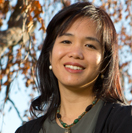 Lalaine B. Little chartered a boat to a Philippine island, cajoled the locals to drive her to a hill overlooking the coast and spent hours poking through three centuries of Filipino history.
Lalaine B. Little chartered a boat to a Philippine island, cajoled the locals to drive her to a hill overlooking the coast and spent hours poking through three centuries of Filipino history.
There, she found her future.
Materials from Africa, artisans from China and designs from Spain, all bolstered by trade with the Americas: The fortified church was a visible recreation of the fusion of cultures that has created the modern Philippines. All right there, from architecture to iconography.
Little, a doctoral student in art history, finds that kind of cultural blending fascinating. “I’ve always been interested in the visual exchanges between the West and Asia,” she says. “And I’ve been fortunate to get funding to visit.”
What she found on that hilltop — something that dots the 7,000 Philippine islands — was a key moment in modern Filipino culture: Pacific Islanders who imported ivory and other materials from Africa — and some of that culture; who drew artisans from China — and their culture; who attracted Spanish priests looking to spread European faith — and economic models.
The icons and architecture were needed to impress cultural values on an indigenous population. The fortifications protected communities from pirates. And despite strict Spanish control of the designs, there’s no eliminating the fusion of African and Chinese influences.
The churches bear a functional similarity to fortified cathedrals in Germany and Romania, Little says, but those were built in communities where Catholicism was already prevalent. These churches had the dual need to convert people.
The work, says Nancy Um, Little’s adviser, “has never been done before. She’s really pioneering in the field.” Little is bringing together a record of religious and devotional objects from a perspective of art history, and analyzing them with historical records.
For Little, this is gold. She has already secured a fellowship at the Lilly Library in Indiana and grants to visit Europe as well as the Philippines. “That fieldwork aspect is very important,” says Um, an associate professor of art history.
Little, who earned a bachelor’s degree in political science before pursuing a master’s degree in art history, also spent time last year at the Newberry Library in Chicago, examining 18th-century Filipino manuscripts. She’s looking for traces of immigration and hiring of Chinese workers.
“I’m peeling back the layers,” she says. “It’s more than just evangelizing — there are political and economic factors. There might be just one sheet of paper I find, but I that’s what I love. I’m a historian.”







